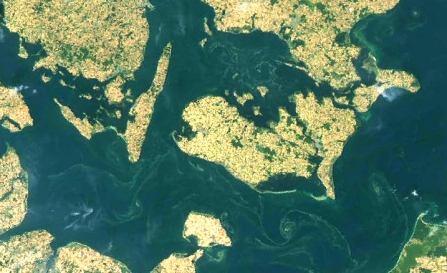Excessive growth of plankton algae increases the amount of organic matter
settling to the bottom. Harmful algal blooms may cause discoloration of the
water, foam formation, oxygen depletion, death of benthic fauna and wild or caged fish, or
shellfish poisoning of humans. Increased growth and dominance of fast growing
filamentous macroalgae in shallow sheltered areas is yet another effect of
nutrient overload which will change the coastal ecosystem, increase the risk
of local oxygen depletion and reduce biodiversity and nurseries for fish.
More on algal blooms in particular and on eutrophication in general in the EEA report Eutrophication in
Europe's coastal waters. The structure of the report generally follows
the DPSIR assessment framework,
where D = driving forces, P = pressures, S = state, I = impacts and R =
responses.
The DPSIR framework for marine eutrophication is illustrated in Figure
1. Driving
forces and source apportionment are not main topics and are only briefly
mentioned in this report, which concentrates on pressures, state, impacts and
responses.
Other reports from EEA on algal blooms and eutrophication:
Indicator:
Other sources for information on algal bloom
Several institutions in Europe are involved in the monitoring and assessment of
eutrophication using satellite images and can supply more detailed
information on specific areas.
 Figure 2: Satellite image on algal bloom in Danish and German waters
Figure 2: Satellite image on algal bloom in Danish and German waters
Source: DMI, image enhanced by PhD. Peter
Viskum Jørgensen, DMI.
Note: The image is made by the Aqua-satellites
MODIS-instrument (Moderate-Resolution Imaging Spectroradiometer) on Thursday
7 August 2003 at 14:00. The algae are visible as the white and green colored
strings in the water.
Links:
Read more

 Figure 2: Satellite image on algal bloom in Danish and German waters
Figure 2: Satellite image on algal bloom in Danish and German waters
Document Actions
Share with others